This week’s post is a guest article by Ben Brandall, a writer for Process Street.
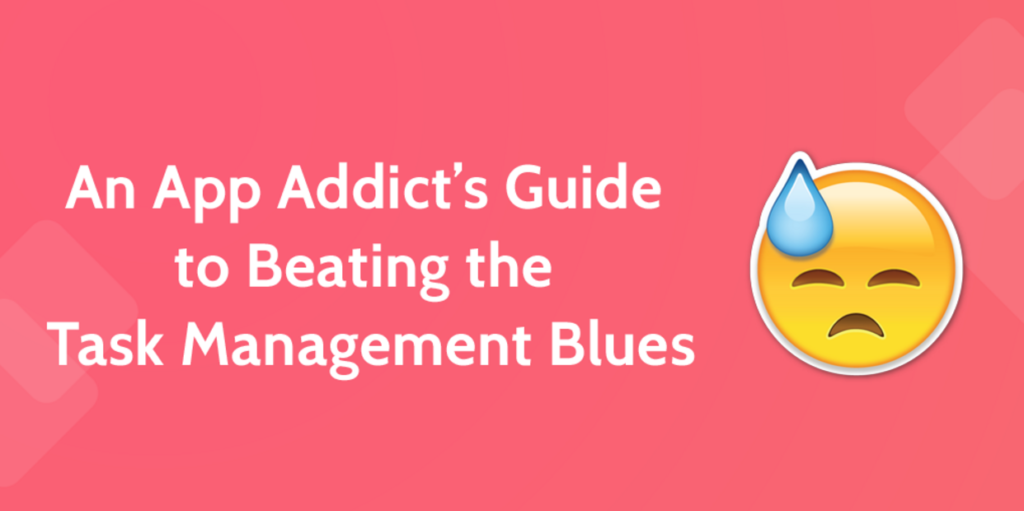
Last weekend I found myself in a cafe, alone and without a laptop for around 2 hours. With just my phone, I wanted to do something worthwhile so I decided to organize my tasks properly — something I hadn’t done in a while.
I realized pretty quickly that my task management system made no sense at all.
Embarrassing. Especially since I’ve been writing for money for the past 4 years — which means managing projects, tasks, and keeping well organized — and my task management skills haven’t really improved.
I’ve always been able to get away with my own brand of task management, spurred on by the idea that I won’t get paid until the article is written.
Now that I’m on a salary and tackling several projects at once whilst learning what marketing even is, I’ve given in to the unromantic world of being organized and set out to get myself in line and boost productivity.
For someone like me (e.g: messing around on apps constantly), a solution for task management should be elegant, enjoyable and more productive than if it weren’t to be used at all. The latter requirement was the hardest to meet, and a lot of apps I tried disorganized me further or consumed more time than they saved.
With 2 hours to overhaul my task management system and 1 week to test it out, I’d like to share what I found so you too can get things done, hit deadlines and stop accidentally slacking off.
How did someone who couldn’t settle on any single app manage to develop a proper task management system?
Let me try and get my ideas straight long enough to tell you.
The problems I have with task management
Because I have to collaborate with multiple people, I end up collaborating over different apps depending on who I’m collaborating with. These are apps which lend themselves to different kinds of use and level of detail — like how Trello has room for everything but Any.Do is just a to-do list.
I’ve experimented with dozens of different apps including Trello, Process Street, Any.Do, Wunderlist, Todoist, Evernote, Asana, Inbox, iOS Reminders and more.
I like to try as many apps as I can, and it’s even part of my job to review them.
With a phone containing apps for every major todo list, it’s easy to flit around and be disorganized but it also helps me figure out what a task management systems should and shouldn’t do because there are plenty I left behind on my journey.
How many to-do lists are you willing to manage simultaneously? If you’re sane, the answer will be a resounding ‘ONE!’. It’s a nice thought, and could be possible with the right app and right amount of hacky integrations, but also a hell of a lot harder than expected.
Before I start singing you my task management blues, I’ll give you a definition of what I mean:
Problem 1: too many apps!
I feel like no matter what I do, I will always have to use a minimum of two-three apps to get my work life in order.

That’s because I need an app where the ‘meat’ of the project is stored (where I can store images, links, and files, @mention other people, etc.). I’d also need a second app as a dedicated to-do list. Something that isn’t for reeling a comprehensive list of tasks off at me, but something I can glance at and say “oh, here are three things I need to do before bed today”.
The third app I need is something to manage recurring tasks. While many todo lists will notify you about recurring tasks daily, I need both something to handle predictable processes (like support tickets) and things which are triggered by other factors (pre-publishing checklists, keyword research, etc.).
The important distinction is that to-do lists are great at helping you prioritize your day, but not as a source of rich content and collaboration.
Problem 2: the apps need to integrate
The apps need to link together and send information to each other. If I add a task to my to-do list, it should go to wherever else it needs to go, too.
That’s because there’s absolutely no point in up keeping a bunch of lists. I tried it for a while, got a headache and abandoned it. There is an app out there that can handle what you need to do, but apps are tools, not obvious solutions that can do all of the work for you.
Problem 3: I’m already entrenched in a clumsy task management system
Inbox for Gmail is so good that I can’t leave it. However, since it’s just an interface and only just gone public there are no real integrations for it. If I want to be able to link reminders to emails in a few clicks, it seems I’ll have to keep email-related to-dos in one place and non-email related ones in another place. That’s no good at all. There’s also no way to use Inbox as a dedicated to-do list.
My workflow looked similar to, but worse than this:

(Not a real problem: I’d like to get to-dos to show up on my calendar with the rest of my events…)
With this in mind, here’s what I tried.
The first failed attempt
For prioritizing tasks, my first port of call was Any.Do. That’s because of its quick day overview with task snoozing called Moment.
Moment shows you tasks due for today or without a due date and asks you if you want to schedule them for today, tomorrow, next week or sometime in the future. It’s the procrastinator’s to-do list.

Because of the way Any.Do works, it’s way too easy to push tasks to tomorrow, over and over again. No one wants to see they have snoozed a task for 32 days in a row. But that’s not why I abandoned it.
The biggest pain of all (and something I tried hard to hack around) is that Any.Do doesn’t integrate with anything. I don’t keep my tasks on to-do lists — they live on Trello. I’m not going to spend more time copying tasks from Trello to Any.Do when I could find a solution that integrates.
My situation isn’t yours, of course. If you’re a lone wolf then a todo list like Any.Do will probably suffice. If not, you’ll need something that integrates and is collaborative or you’ll waste time on organizing your organizational apps.
My original task management process was to check what’s in my Doing list on Trello and eat the frog.
As I got involved with more projects, the list of different boards to check became way too long so I added my frog tasks to Any.Do and organized them accordingly.

That meant that I had an extra task on my list before I could even start the day: comb through my active Trello boards and note down priority tasks. What’s the point in such a workflow, you may ask?
At that point I had to upkeep Trello cards, to-do list items, email reminders which stick in Inbox and can’t be fed out into a todo list, action items in WorkFlowy, etc. In short, it was a ridiculous system that made me feel totally unproductive, overwhelmed and sad.
The solution
Since then, maybe 5 or 6 days ago at the time of writing, I’ve found a solution I overlooked in the past — a very beautiful one, I may add.
To recap — here’s what I need from a task manager:
- Daily summary view
- Trello integration
- Due dates/Reminders
- Email tasks to a list
- Recurring tasks/workflows
- A place to summarize my done items
Not so much of a tall order, right?
Well, as I said before, I need a minimum of 2 apps to accomplish this as well as a third to satisfy the need for workflow automation my error-prone self is now so accustomed to.
Here’s my new setup:
Wunderlist syncs with Trello, feeding tasks from one list…
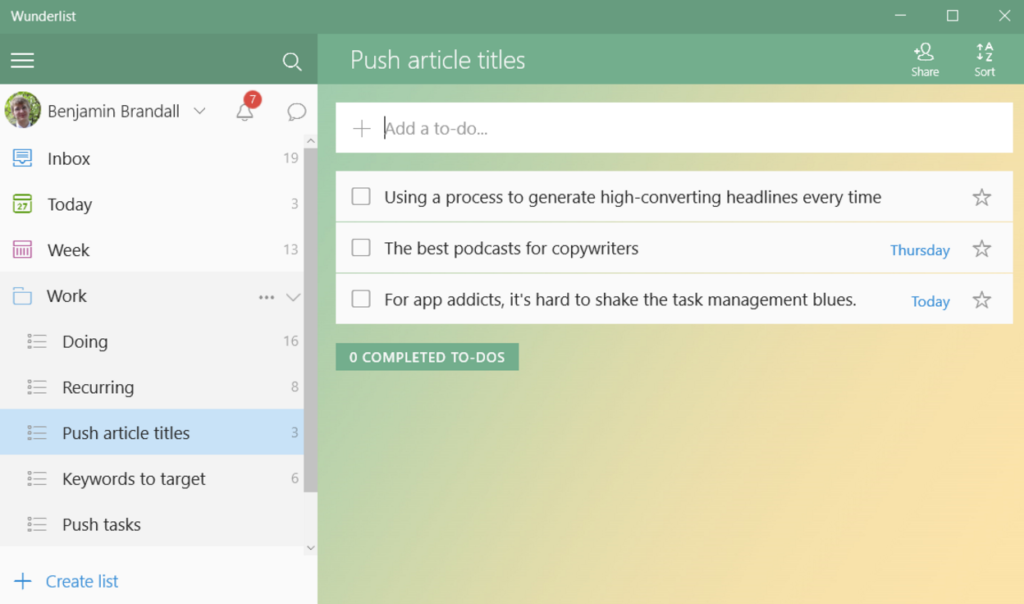
…to the blog articles list on Trello, for approval, discussion, and collaboration. It works with this Zapier integration.

I schedule my daily/weekly recurring tasks on Wunderlist, with a time added for push notifications.

I manage any complex recurring workflows or workflow automation with Process Street. This means stuff like pre-publishing checklists, keyword research or customer support processes.

I still collaborate with others over content/PR using Trello because that’s the foundational, must-have, high-level task management app.
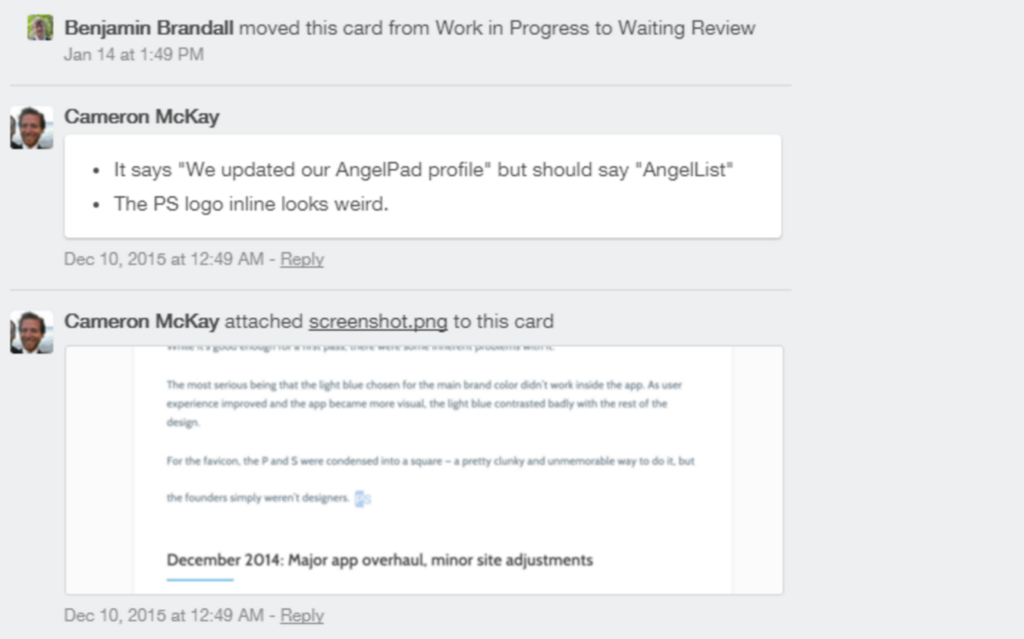
Any emails that need detailed replies are forwarded to Wunderlist (emailed to me@wunderlist.com from the account associated).

I tag Wunderlist tasks by length, so if I eat all my daily frogs and have time left over, I know what can slot in there. For example, ‘Pitch SEMrush #quick’. Tapping the #quick tag shows all other quick tasks so you can clear out your pesky little tasks in short order.
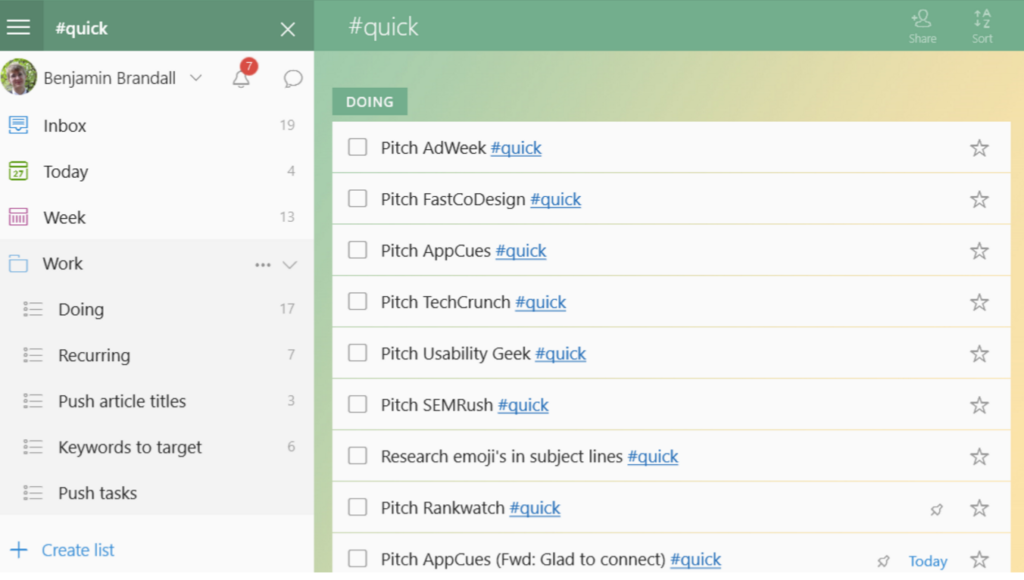
My ‘Inbox’ list on Trello syncs with my Wunderlist Inbox, and I can prioritize tasks at a glance. If my ‘Today’ smart list is too big and hectic and I need to focus it down, starring the most important one or two tasks from it creates a new smart list and focuses me on what needs doing urgently.

Since Wunderlist hides completed items and it’s difficult to get a clear idea on what work is completed, I send my checked off items to iDoneThis, where I can get an email summary of all done tasks.
To set this up, just link Wunderlist to iDoneThis, again using Zapier. Link completed Wunderlist items to your done list, like this:

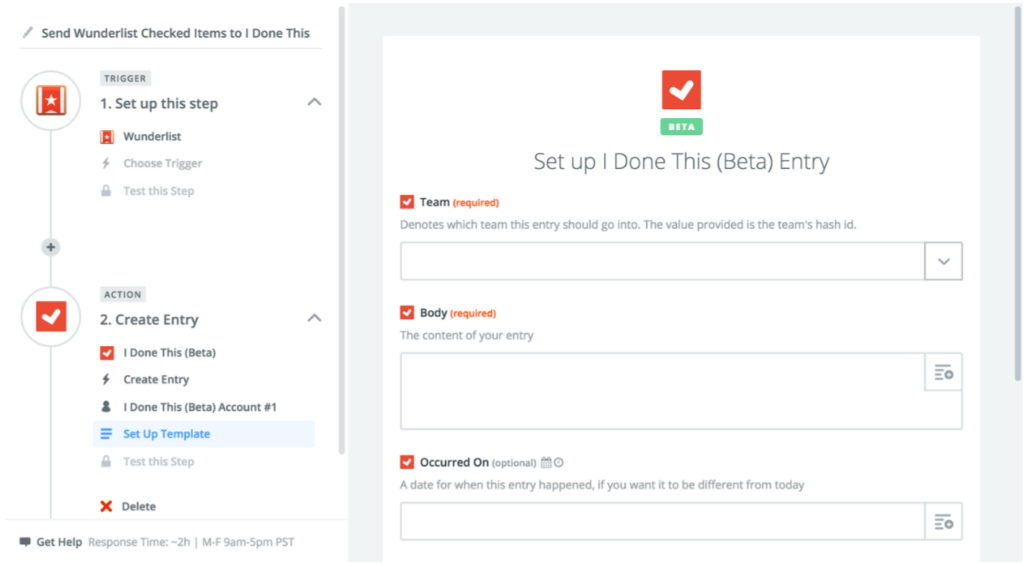
Seeing an overview of your completed tasks gives you an idea of whether you’ve accomplished important work that day or week. That brings me onto the next question which needs to be answered to get a grip on task management…
You’ve got a list of 20 tasks. Which one’s the ‘frog’?
I made a reference earlier in this article about eating the frog. I hope you caught it, or that subheading would have made no sense. Eating the frog is a concept written about by Brian Tracy, derived from this wonderful Mark Twain quote:
“Eat a live frog first thing in the morning and nothing worse will happen to you the rest of the day.”
Eating the frog means tackling your least favorite task first. It’s your least favorite for a reason. Probably because it’s urgent, important, laborious, long, complex or a combination of all these exhausting traits. It’s a task you don’t want to do but must do.
Have you got 2 frogs to eat? Then you eat the ugliest one first.

So, browsing your list of tasks, whichever task your eyes avert from and you wish wasn’t there, that’s the frog. It’s the task you’ve been putting off for 2 weeks in favor of inbox zero-style busywork.
The difference between ‘urgent’ and ‘important’
As chance would have it, on the day where I’m sitting down to tackle a post on task management I get an email from Seth Godin about the difference between an urgent task and an important one. Even though I’d planned on Googling it since it was in the outline, Seth offered an interesting take on the matter:
“Mollifying an angry customer is urgent, building systems and promises that keep customers from getting angry is important.
Killing the bugs in the kitchen is urgent, putting in weatherstripping to keep them out for the long haul is important (as is avoiding carcinogens).” — Seth Godin
From these examples, I can deduce that you should get your urgent tasks out of the way in order to put hard work into the important ones.
Urgent tasks are tasks you don’t have the luxury of time to complete, whereas important tasks are ones which will take time to complete.

With this in mind, that means my new system looks like less like a bunch of dead ends and data entry, and more like this:

(That blue diamond is Process Street, by the way!)
It took a minor amount of fussing with different systems, but thanks to integrations, timeless task management wisdom and more common sense than I’m used to, my new system is a total success.
After this journey, I’m really interested in hearing how other people manage their tasks in a way that fits in with the way they think. I’d love it if you could let me know in the comments the way you do it. 🙂
P.S. If you liked this article, you should subscribe to the IDoneThis newsletter. We’ll email you a daily blog post with actionable and unconventional advice on how to work better.
